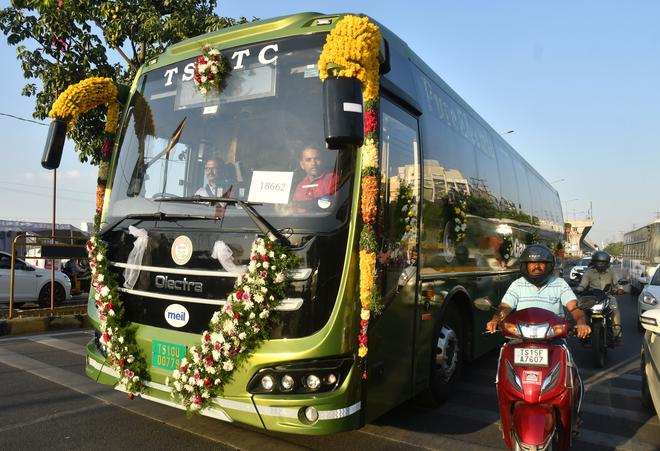
After the formation of Telangana, the Telangana State Road Transport Corporation (TSRTC) has had a bumpy ride. From incurring losses on account of continuous hikes in diesel prices and the COVID–19 pandemic, to an ageing fleet, and from the 52-day strike of 2019 that paralysed public transport, to positives such as the introduction of inter-State electric buses, soon-to-be-introduced double decker buses, and improving staff and vehicle efficiency, despite all the odds.
The TSRTC is the go-to transport option each day in the State for an overwhelming 82.50 lakh passengers spread over more than 3,200 routes across Telangana.
The biggest challenge to the TSRTC came during the COVID–19 pandemic. Given that a vast majority of its buses were off the roads resulted in a massive loss of revenue. But, true to its nature of performing public service, staff working during the pandemic were at the forefront of transporting essential service workers and those in need. For instance, the transport juggernaut ran 3,278 trips to transport migrant workers. Hospital staff too used TSRTC services to reach their places of work. The Corporation ran 7,173 trips for nurses and other such staff.
A factor that drove the TSRTC into crushing losses were the rising diesel costs This prompted the Corporation to identify retail fuel stations and procure from them.
But before the pandemic, the TSRTC witnessed one of the most significant events in its history — the 52-day workers’ strike. As many as 10 unions joined hands and issued a list of 26 demands that included a ‘merger’ of the TSRTC with the government. Other demands were over better working conditions for women staff, such as holidays for childcare. The government declared the strike illegal and invoked the Essential Services Maintenance Act.
Telangana Chief Minister K Chandrasekhar Rao refused to relent, and declared the workers as ‘self-dismissed’. He issued deadlines for them to join duty. Only a few complied. The then government pressed into service and hired conductors and drivers. However, several service issues were reported. The unions still maintain that what is due to them has not been given, including calling for fresh union elections, and payment of arrears.
On June 15 last year, the TSRTC celebrated the 90th year of its existence. The original manifestation of the Road Transport Department saw, for the first time in the history of Hyderabad, a red Albion bus rumbling from the Machli Kaman near Charminar towards Secunderabad. From a fleet of around 27 buses, the present-day TSRTC has around 9,500 buses.
While the transport juggernaut has kept in sync with the changing transport landscape, in the recent past, under the leadership of Chairman Bajireddy Govardhan and Managing Director V. C. Sajjanar, a slew of passenger-friendly measures have been taken. Travel as You Like (TAYL), T–6, and F–24 tickets were launched. While they initially received a lukewarm response, TAYL began selling about 24,000 per day, translating into a revenue of ₹24 lakh per day, and T–6 sold around 4,000 per day.
To help passengers plan their daily trips, The TSRTC launched its bus tracking app. Other initiatives include responding to complaints on Twitter, and at its call centre, which receives several hundred call per day.
In a boost to its environment and passenger friendly initiatives, the TSRTC launched its first electric bus service, e-Garuda buses, from Hyderabad to Vijayawada. While 10 electric buses were flagged off recently, the plans is to shortly increase the numbers to 50. A procurement of a much larger number of electric buses, including double deckers is in the offing.







